Best gaming keyboard 2025: our favourite 13 mechanical and non-mechanical options
From big gaming brands to boutique alternatives.
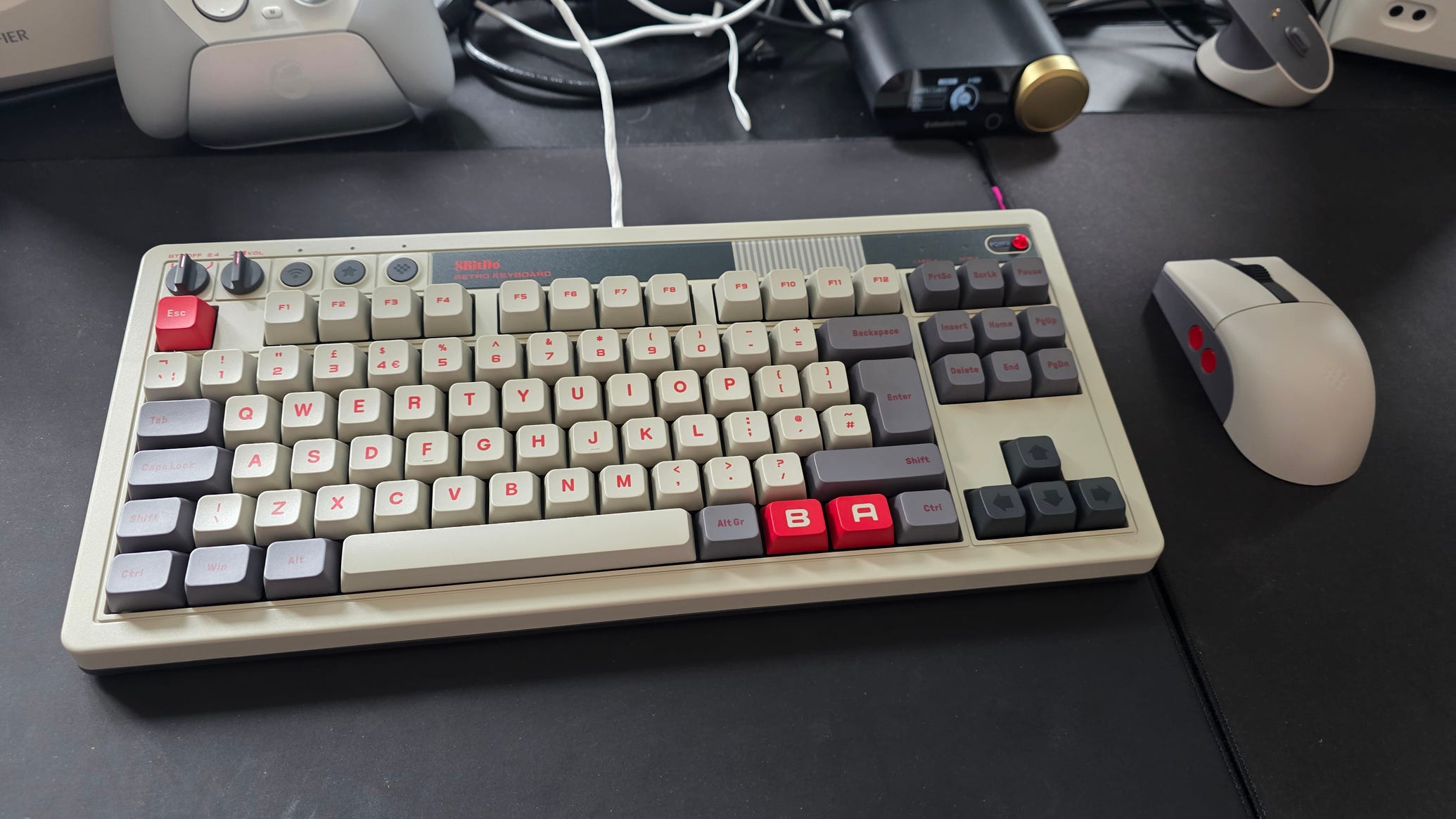
A great gaming keyboard is central to excelling in PC gaming, coming just behind the mouse in terms of the most important peripherals. I've been testing keyboards for 15 years now, and I've come up with this list of my current favourites - options that are quick, customisable, easy to use and with powerful extra features.
If you're in a rush, our number one recommendation is the SteelSeries Apex Pro, a mechanical keyboard with magnetic switches, a great typing experience and a distinct aesthetic. It's available in multiple sizes too, so you can choose the one that's best for you.
Of course, we have a lot of alternative picks too, including mechanical and non-mechanical options.
Best gaming keyboard 2025
- SteelSeries Apex Pro: a beautiful design with plenty of extras
- Corsair K100: a full-fat mechanical with truly unique features
- Nuphy Halo96 V2: a compact full-size layout with impeccable aesthetics and typing feel
- SteelSeries Apex 3 TKL: the best membrane keyboard available
- Keychron K3: a compact and low profile optical switch keyboard
- Fnatic Streak80 LP: a beautifully-designed low profile TKL keyboard
- Hyte Keeb TKL: a unique design with a great typing feel
- Trust GXT 867 Acira: a great budget mechanical keyboard
- Logitech G Pro X TKL Lightspeed: a rare premium wireless mechanical gaming keyboard
- Ducky One 3: superior key feel, simple yet evocative design
- Trust Gaming GXT 856 Torac: the best cheap membrane keyboard
- Cherry Xtfry K4v2: great value gaming keyboard with MX2A switches
- Gamiac TKL90G: a cheap UK mechanical keyboard with good bones
1. SteelSeries Apex Pro Gen 3 / Apex Pro TKL Gen 3
This keyboard boasts hyper-advanced features while still nailing the essentials
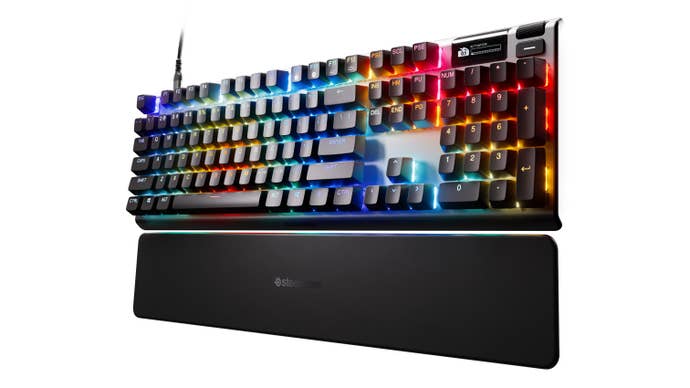
- Pro: Magnetic switches with FPS-focused features
- Pro: Bright RGB backlighting and beautiful design with an OLED display
- Con: Premium price, though it's justified by the upgraded key feel and feature list
- Check price: Gen 3 at Amazon UK/Amazon US
The SteelSeries Apex Pro is our new top pick, thanks to its strong fundamentals, an upgraded typing experience and truly meaningful extras. The first thing you're likely to notice is the OLED screen in the upper right, which allows you to see your in-game stats, chatters in Discord or the music you're playing; it also lets you adjust settings using the convenient volume wheel nearby. This feature even makes it into the smaller TKL (tenkeyless) version, though the volume wheel is substantially thinner.
Less obvious but more impressive are the third-gen Omnipoint magnetic sensors built into each switch, which can measure how far down each key has been pressed and therefore unlocks a long list of gaming-focused features. For example, rapid trigger allows a key press to be registered as soon as the key starts travelling down rather than until it passes through a fixed point, while SOCD ("snap tap") allows you to stop on a dime while strafing in FPS titles like Valorant or Overwatch 2. You can also adjust your actuation point on a per-key basis to alter the keyboard's sensitivity, protect against typos, assign multiple functions to the same key and many more things, all available via SteelSeries' advanced GG software package.
As well as offering advanced features, the Apex Pro is just a nice keyboard to look at and to use. It feels well built, with an gently rounded aluminium alloy frame, and its bright RGB backlighting spills out of the large capital letters on each keycap. The most recent Gen 3 models come with improvements to typing feel, with pre-lubricated key switches and sound dampening foam built into the case producing a smooth, soft and satisfying key press. Together with the upgrade to PBT keycaps with the Gen 2 model, this is now one of the best typing keyboards available from a major gaming brand - which we love to see.
The SteelSeries Apex Pro has continued to climb in price with its recent upgrades, so it is definitely a premium option available only for a lucky few. We do have several more affordable recommendations below, but if you have the cash then you do get a strong do-anything keyboard with the typing feel, gaming features and software support to match.
2. 8BitDo Retro Mechanical Keyboard
A beautifully designed retro revival that feels as good as it looks
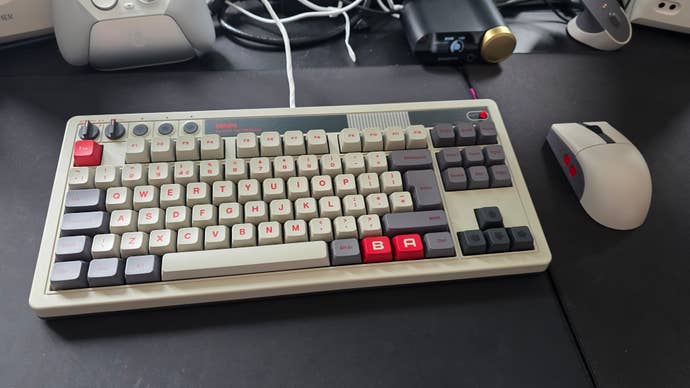
- Pro: Incredible retro stylings to match classic sonsoles at a reasonable price
- Pro: Excellent typing feel with useful extra buttons
- Con: Relatively loud thanks to its clicky switches and without any special FPS gaming features
- Check price: Amazon UK/Amazon US
The 8BitDo Retro Mechanical Keyboard is easy to recommend for anyone of a certain vintage, with models that ape the visuals of the NES (shown above), C64, Famicom, Xbox or just old PC keyboards. (There's also a matching NES-style mouse.)
The resemblance is more than skin-deep too, with pleasantly tactile and clicky Kailh Box White switches, one of my all-time favourites for typing and gaming, durable PBT keycaps and even an extra oversized button box that can be set up to perform macros. Elsewhere on the keyboard itself, you'll find convenient switches to swap between USB, 2.4GHz and Bluetooth connections, adjust your PC volume or perform other useful functions.
The retro stylings here mean that this is a relatively large keyboard for its layout, in contrast to more streamlined modern designs, but I'm happy to invest a little more desk space in a keyboard this delightful. Similarly, the clunky switches are perfectly responsive, but can be a bit loud for rapid hammering in a shared space. Thankfully, the switches are hot-swap if you love the look but want a different feel.
Overall, a hugely impressive keyboard for the money, and well worth recommending near the sharp end of our gaming keyboard favourites.
3. Nuphy Halo96 V2
A compact full-size layout with impeccable aesthetics and typing feel
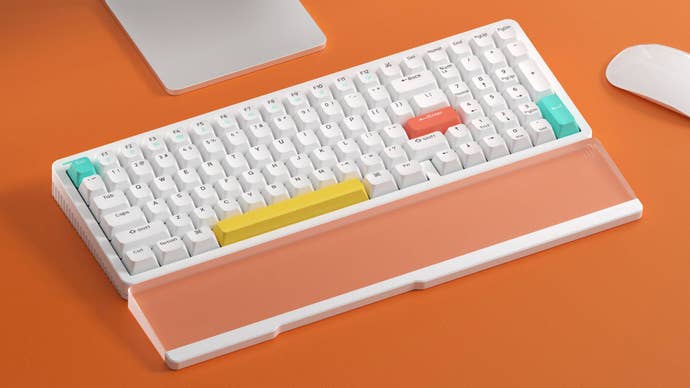
- Pro: Stylish design in black or white with great switch options
- Pro: Compact despite the full-format layout with numpad
- Con: V2 models are more expensive
- Check price: Nuphy Store (use code DF10)
The Nuphy Halo96 wireless mechanical keyboard is a fantastic choice for gaming or working, with a compact full-size ANSI/US layout, a beautiful colour scheme in white or black, optional RGB back/edge-lighting and full Mac/Windows compatibility with wired and wireless connectivity. The keyboard is supremely built, with a high-profile unibody aluminium frame, and feels incredible given its reasonable price point (especially with our discount code, below).
I particularly enjoyed the feel of this keyboard with the Rose Glacier switches installed, which provide a much more noticeable tactile response than standard MX Brown tactile switches - great for typing, but also ideal for RTS and other genres where key accuracy is critical.
The keyboard is hot-swappable and can be purchased with plenty of other interesting switch options too, from more standard G Pro Red and Brown switches to pre-lubed Night Breeze, Baby Raccoon and Baby Kangaroo options. All of these choices benefit from a special silenced space bar and layers of silicone to produce soft, deep and eminently satisfying typing sounds.
Overall, the Halo96 is a fantastic board, especially when paired with the acrylic/aluminium wrist rest shown above. This looks almost like glass, diffusing the edge RGB throughout the wrist rest and making the keyboard comfier to use too.
4. SteelSeries Apex 3 TKL
The best non-mechanical membrane keyboard we've tested
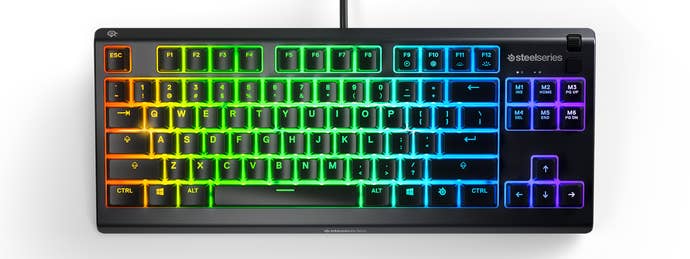
- Pro: Membrane keys provide a soft, quiet feel perfect for shared spaces
- Pro: Eight-zone RGB lighting is bright and effective
- Con: Key rollover remains a limitation for membrane keyboards
- Check price: Amazon UK/Amazon US
If you prefer the softer feel, quieter operation and lower cost of non-mechanical keyboards, the SteelSeries Apex 3 TKL is the best we've tested so far. The membrane switches offer a decent amount of tactile feedback but require a relatively strong touch compared to mechanical keyboards. Like the Roccat Magma, our previous pick, RGB LEDs shine through a layer of semi-frosted plastic, diffusing the light evenly across the keyboard, which looks great. The membrane keys are also water and dust resistant, with an IP32 rating that means they should survive a few spills - although something like sweetened tea or cola will probably gum up the works somewhat.
In terms of extra features, this tenkeyless keyboard has a rare volume wheel in the upper right and a button that's set to play/pause by default. This can be customised in the SteelSeries GG software, which also allows different lighting modes and key assignments.
However, the keyboard does have one major disadvantage. Despite claiming "gaming-grade anti-ghosting technology", the keyboard doesn't offer as high a key rollover count as we'd expect. For example, with Q and W held down, you can't press down 0, H, J, comma or period. This means the keyboard only has a rollover count of two (2KRO), and six is the standard for a good gaming keyboard. Sadly, this is often a downside to choosing membrane over mechanical, and is worth bearing in mind if you are a fast typer or play games that require a lot of simultaneous key presses (like rhythm games or co-op games with two players on a single keyboard).
5. Keychron K3
A compact and low profile optical switch keyboard
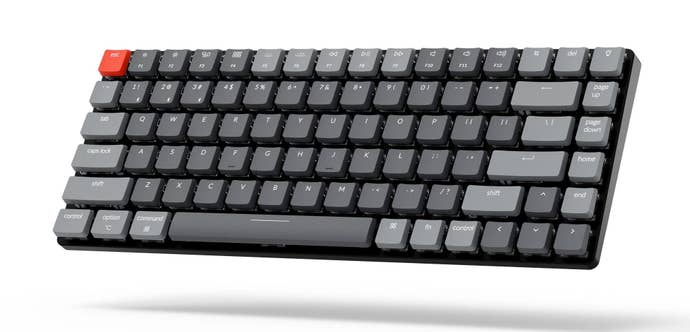
- Pro: Low profile optical switches in linear, tactile or clicky variants
- Pro: Minimalist, portable and Mac-friendly design with detachable USB-C cable
- Con: Low profile design means fewer keycap and switch replacement options
- Check price: Amazon UK/Amazon US
The Keychron K3 proves that you don't need to spend a lot to get a beautiful keyboard, modern features and excellent build quality. The K3 uses rare low profile optical mechanical switches, with a choice of clicky, tactile or linear options. These, combined with the compact 75 percent layout, make for a typing experience akin to the best laptop keyboard you've ever used.
The optical sensor built into each switch ensures key presses can be registered in an instant, equalling the responsiveness of much more expensive gaming keyboards like the Razer Huntsman TE we featured in a previous version of this article. Keychron's optical switches are also hot-swappable, making it easy to replace a broken switch or change to an entirely different feel later on. (If you're not sold on optical switches, then you can get regular Gateron low profile switches instead for a slightly lower cost, but note that these aren't hot-swappable.)
As well as performing well in games, the K3 is also one of the few Mac-friendly keyboards on the market, with both Mac and Windows keycaps available. If you ever have occasion to use a Mac, you'll no doubt appreciate the hotkeys along the top row of the keyboard and the alternate Mac modifier keycaps. The keyboard should be used via USB-C for competitive gaming, but Bluetooth is also available with around 30 hours of battery life - so you can use it comfortably with the iPhone and iPad, in addition to a wide range of other computers and mobile devices.
All in all, the Keychron K3's compact size, excellent switches and overall aesthetic makes it one of our favourite keyboards for gaming or typing. This keyboard is also uniquely in-demand here at Eurogamer's Bristol office, and disappearing on many occasions because someone fancied using it for work. If that's not a tacit recommendation, I don't know what is!
6. Fnatic Streak80 LP
A beautifully-designed low profile TKL keyboard
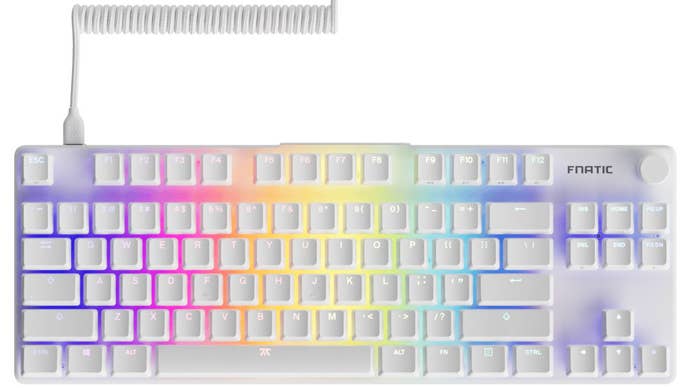
- Pro: Streamlined low profile TKL design with volume wheel
- Pro: High-quality PBT keycaps atop lubed switches and stabilers with insulating foam
- Con: No high polling rates or magnetic switches
- Check price: Amazon UK/Amazon US
The Fnatic Streak80 LP is one of those keyboards that you plug into your computer and instantly fall in love with, thanks to its sleek and gently rounded design, strong RGB and fancy coiled USB cable. This keyboard just looks a million bucks - and it feels fantastic too, with Fnatic catching up with mechanical keyboard trends with lubed switches and stabilisers, insulating foam and premium-feeling PBT keycaps. These make for a great-sounding keyboard as well, with the low profile linear switches feeling smooth and producing a deep clatter.
For gaming, the Fnatic keyboard doesn't include the 2000Hz or higher polling rates found in some competitively-minded options, nor the optical/analogue switches that unlock the trendy rapid trigger technology preferred by some FPS players and popularised by the Wooting 60 HE. Similarly, only a US ANSI layout is offered, evidence of what I imagine is quite a limited production compared to giants like Corsair, Razer and SteelSeries, and the switches aren't hot-swappable which may disappoint some enthusiasts.
Still, this is a comfortable high-performance keyboard for competitive play and without a doubt the finest low profile gaming keyboard we've ever tested.
7. Hyte Keeb TKL
An incredibly designed TKL keyboard with pre-lubed switches and unique software

- Pro: Eye-catching design enhanced with RGB lighting
- Pro: Convenient volume/RGB rollers and pre-lubed switches
- Con: Expensive, with some software limitations
- Check price: Amazon UK/Amazon US
The Hyte Keeb TKL is a fascinating keyboard that looks totally distinct from anything else on the market, with the titular tenkeyless layout surrounded by a clear polycarbonate "bubble" that's lit up by a huge array of RGB LEDs. Inside, the hot-swap "Fluffy Lavender" linear switches are pre-lubed and multiple levels of sound dampening have been added, both of which contribute to an excellent typing experience out of the box.
You'll also note five extra keys in the upper left, which are mechanical media controls, as well as two rollers above them which adjust the RGB lighting brightness and the volume (quite slowly). The layout is a little cramped, with little space between the rollers, media keys and Escape/F1 keys below them, but I appreciate the inclusion of the media controls regardless.
While there's plenty to like here, there are some annoying aspects to the Keeb TKL too. For example, Hyte opted for high-quality PBT keycaps for the keyboard, but the key legends are extremely generic - I recognise them from cheap-o mechanicals that were available 10 years ago. The light that shines through each keycap is also extremely dim in comparison to the RGB on the periphery of the board, with no way to independently adjust the brightness of each element in the Nexus software. You also can't set each key's lighting independently, or keep your RGB settings going after you close the software.
For the relatively steep asking price, you would expect a near flawless product, and the Hyte Keeb TKL is still a few software updates away from that goal - but if you like the unique design, it's easier to put up with a few minor inconveniences.
8. Trust GXT 867 Acira
A great budget mechanical keyboard
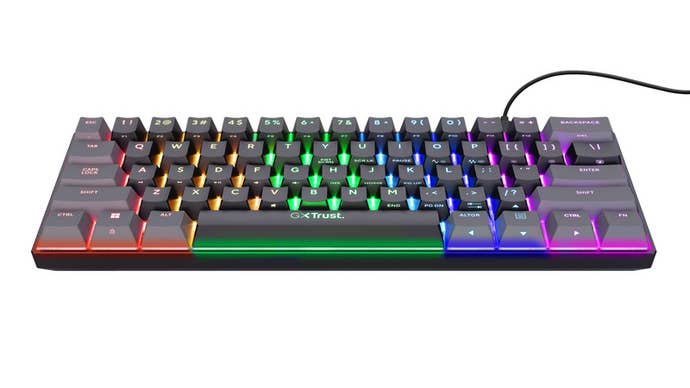
- Pro: Nice grey/black design with RGB backlighting
- Pro: Proper UK layout mechanical keyboard
- Con: Affordable price is felt in a few areas
- Check price: Amazon UK
The Trust GXT 867 Acira is one of the best keyboards I've ever tested at its price point, offering a surprisingly stylish design, full RGB backlighting and a proper UK layout in the 60 percent form factor. With real mechanical switches, you get a lot of advantages over the membrane keyboards that are more common at this price, including a more precise key feel that doesn't degrade over time, upgrade potential, repairability and full n-key rollover (NKRO)*.
*NKRO means the keyboard can recognise an unlimited number of simultaneous keypresses, handy for FPS and rhythm games. Many membrane keyboards, by comparison, have 2KRO - so if you have two keys pressed down already, a third may not be registered.
There are cutbacks to make this price possible - including budget Outemu Red switches, which don't feel as precise as those made by other brands - but the core gaming experience is certainly intact; I'd much rather have a budget mechanical than a high-end membrane. You could also make the case that the ABS keycaps could be upgraded later for fancier PBT alternatives, but you're likely to pay a significant percentage of the purchase price to get something that's a genuine improvement over what's provided.
I'm surprised just how good this keyboard is for the money. It may not have fancy features like rapid trigger or a high polling rate, but for actually playing games it does everything you need.
9. Logitech G Pro X TKL Lightspeed
A rare premium wireless mechanical gaming keyboard
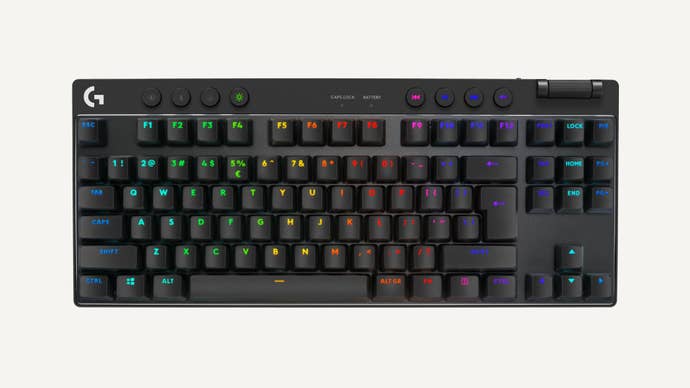
- Pro: Bulletproof Lightspeed wireless, plus USB and Bluetooth
- Pro: Attractively-designed and robust board in multiple colours with good added features
- Con: Expensive, though a cheaper wired alternative is also available
- Check price: Amazon UK/Amazon US
Logitech's keyboards are a mainstay on esports stages worldwide, thanks to the company's sponsorship of some seriously high-profile esports teams, but the Logitech G Pro X TKL Lightspeed is well worth choosing even if you're not at that level (yet).
This keyboard takes design cues from the popular G915, including that keyboard's wide volume roller and additional (non-mechanical) keys above the function row for adjusting connectivity, lighting, game mode, media and volume. Unlike the G915 though, this is a full-height keyboard with Logitech's own GX switches made in the familiar Cherry mould, giving each keypress greater travel and allowing for more tactile and/or clicky feedback. PBT keycaps are provided, though they're a little slicker than some others I've tried recently, and the typing feel as a whole does perhaps lack modern innovations like pre-lubed switches and stabilisers, sound-dampening foam and other elements that are making their way from enthusiast to mainstream mechanical keyboards.
The keyboard is unusual in that it's a competition-focused wireless keyboard, using the same quick and reliable Lightspeed connection as the company's mice and headsets. You do pay a lot for that extra functionality, but perhaps the flexibility it affords - alongside higher-latency, wider-compatibility Bluetooth - makes the higher price worth it. It even comes with a beautiful carry case for taking to LANs.
Similarly, you get a good software solution in the form of G Hub for programming macros, remapping keys and adjusting the lighting, and there's a good argument to sticking in one ecosystem - and with Logitech's traditional mice and headset strengths, this is a good complementary keyboard pick despite its high price.
10. Ducky One 3
Superior key feel, simple yet evocative design
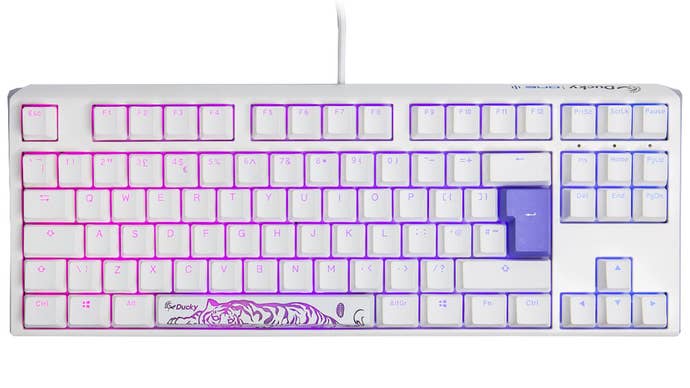
- Pro: A clean design with high-quality components like PBT keycaps and silicone/foam dampening
- Pro: 60 percent, TKL and full-size UK layouts available
- Con: Lacks modern features like higher polling rates or magnetic switches
- Check price: Overclockers UK/Amazon US
The Ducky One 3 Classic TKL is a brilliant keyboard, offering a clean and simple design with a few nice flourishes - including swoopy bezels, an optional Year of the Tiger spacebar and a coloured enter key. The key feel here is excellent, thanks to Cherry MX switches (hot-swappable), silicone and foam dampening and PBT keycaps, which goes some way to justifying the high price.
Otherwise, you get a solid but not exceptional feature list, with a detachable USB-C cable, bright per-key RGB lighting, n-key rollover, three-level feet and a comprehensive Function layer. You could certainly find cheaper keyboards with more features - like analogue switches, additional macro keys, volume rollers, wrist rests - but for actual gaming and typing, I'd probably go for the keyboard that truly nails the essentials. Note that the One 3 is also available in 60 percent and full-size sizes.
11. Trust Gaming GXT 856 Torac
The best cheap membrane keyboard
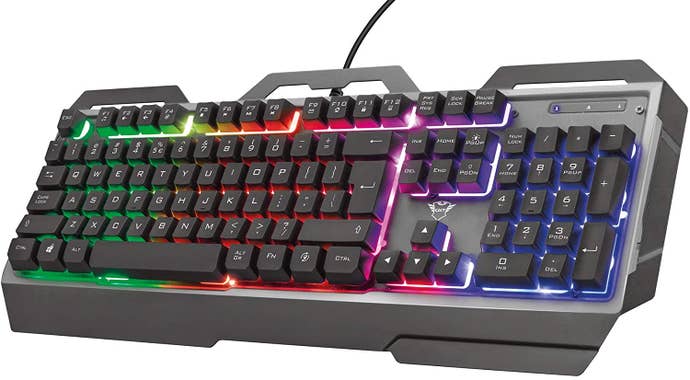
- Pro: Metal construction and very gamer-y RGB look
- Pro: Very affordable, though only available in the UK and Europe
- Con: RGB backlighting isn't customisable
- Check price: Amazon UK
Membrane keyboards get a rap from mechanical keyboard fans, but some people just prefer the soft feel of a classic rubber dome board and there's no denying that membrane boards can be a lot cheaper too. If that's you, then a good inexpensive option to consider is the Trust Gaming GXT 856 Torac. The Torac offers a clear contrast against monochrome and rectangular office keyboards, with bright RGB backlighting and a metal frame that extends beyond that is strictly necessary. The labels on each key are easy to read, while a Function layer allows convenient access to media and volume controls. One potential gotcha is that the lighting here isn't customisable, so you can't set the keyboard to a single colour - each key will always light up in the same colour, unless the lighting is turned all the way down. Older users may prefer something a little more refined, but for the younger audience this keyboard seems to be pitched towards the Torac will do the job nicely.
12. Cherry Xtrfy K4v2 TKL
Great value gaming keyboard with MX2A switches, no software needed

- Pro: Space-saving TKL design with standard layout
- Pro: Deep customisation without software
- Con: Relatively feature-poor
- Check price: Amazon UK/Amazon US
The Cherry Xtfry K4v2 TKL is a simple yet effective gaming weapon, offering soft linear Cherry MX2A red switches, a standard TKL layout, strong backlighting and a no-software approach to customisation.
The MX2A switches are a big improvement on Cherry's venerable designs, though they're still a little scratchy compared to pre-lubed third-party options from boutique brands heavily focused on the typing experience. Similarly, you won't find niceties like sound dampening or gasket mounts, with a more straightforward construction here.
Cherry also hasn't succumbed to peer pressure when it comes to high polling rates and magnetic key switches, which can be useful for gaming but also come with some downsides. Regardless, for a gaming-focused keyboard the most important thing is performance, and the K4v2 worked well in my testing for Black Ops 6 and Counter-Strike 2 thanks to its relatively nimble key actuation. I also like the number of additional functions indicated by small legends on the keys, allowing you to change a lot without the need for software. The backlighting is a bit bright on its lowest non-off setting, but that's a minor gripe.
If you want a reliable keyboard from a major brand at a reasonable choice, this fits the bill nicely.
13. Gamiac TKL90G
A cheap UK mechanical keyboard with good bones

- Pro: High-quality PBT keycaps and reliable mechanical switches on a budget
- Pro: Good build quality, with room for switch, keycap and cable upgrades down the line
- Con: Few gaming-specific features
- Check price: Amazon UK/Overclockers UK
The Gamiac TKL90G is a reliable gaming keyboard available for under £50, yet it still benefits from hot-swap Kailh red linear mechanical switches, PBT keycaps and per-key RGB lighting. As with other mechanical keyboards, you also get full n-key rollover, meaning you can press as many keys simultaneously as you want and the keyboard will recognise them all - something that is a big issue for the non-mechanical keyboards that normally float around at this price.
This is a great starter keyboard then, as it performs perfectly well in its stock iteration, but could feel a lot better down the line if you swap out the switches or keycaps for slightly higher-end alternatives. Being able to swap out components also means that repairing any damage is much easier than it is with non-mechanical keyboards.
Our review unit is in a brash red/white colour scheme, with a black/grey option offering a more sombre look. The TKL90G is tenkeyless, meaning it drops the number pad for a more compact layout, while the sister TKL69G opts for an even tighter 65 percent layout. Elsewhere, the TKL90G benefits from the rising tide of mechanical keyboard development, with hotkeys to swap between Mac and Windows layouts, control the backlighting, skip songs and even open the calculator or start a search with the tap of a button. There's also a detachable USB-C cable, an improvement in terms of portability, repairability and customisability.
The TKK90G doesn't include any higher-end gaming features, like higher polling rates or special modes to reduce input lag, but at its price it honestly doesn't need to - the keyboard is already plenty capable.
Frequently questioned answers
What's better, mechanical or non-mechanical?
It depends! Mechanical keyboards feel better to type or game on for many people, and are sometimes described as faster or more responsive. While membrane keyboards harden over time, mechanical keyboards provide a consistent experience for decades. Mechanical keyboards are also available in many different switches, each of which has their own characteristics - loud versus quiet, tactile versus linear, long travel versus short travel and so on.
However, mechanical switches are expensive to produce and often sound louder than their non-mechanical counterparts. By comparison, non-mechanical keyboards tend to feel softer, cost less to produce and don't sound as loud. While both options have their objective strengths and weaknesses, it often comes down to personal preference.
What types of mechanical keyboards are there?
Mechanical keyboards are defined by their switches. The most common options are MX switches, originally made by Cherry and now made by a range of manufacturers. Each switch is described by its colour; the three most popular are as follows:
- Blue: Clicky and tactile, with a relatively high actuation force
- Brown: Not clicky but still tactile, with a relatively low actuation force
- Red: Linear, not clicky or tactile, with a relatively low actuation force
Clicky feedback is fun and can make typing easier, but it can be annoying to others - especially if you're in an shared space or streaming. Tactile feedback also makes it easier to know when a key has been pressed, which can be handy for typing or gaming. Linear switches eschew this added feedback, but operate more smoothly and are therefore most commonly selected for inclusion in gaming keyboards. As usual though, a lot of this comes down to personal preference so experimentation is key.
Since mechanical keyboards became popular about ten years ago, there has been explosion in the numbers of mechanical switches available. Many peripheral producers, such as Razer and Logitech, now make their own proprietary switches which are takes on the original Cherry MX design. The most common modifications allow for faster keypresses (e.g. MX Speed Silver), quieter operation (e.g. MX Silent Red) and improved RGB backlighting (e.g. MX RGB Red). We've also seen the introduction of more major redesigns, such as including optical sensors in order to offer adjustable actuation points or full-fat analogue switches as in the Wooting One, above. Laptop-style Cherry ML switches are also becoming a thing.
What types of non-mechanical keyboards are there?
There are quite a few options, with the most common being traditional membrane keyboards that use a dome of rubber beneath each key to let you know that your key press has been recognised. Hybrid switches, sometimes described as 'mecha-membrane', attempt to provide additional tactile feedback, similar to a mechanical switch, without giving up the low cost and soft feel of a membrane. Scissor switches are another option, which provide a little more tactile feedback and a short travel distance, like you'd expect to find on a laptop.
What is the point of keyboards that don't include the number pad?
Many keyboards, particularly mechanical ones, don't include the number pad. This might be done for several reasons: to lower manufacturing costs by reducing the number of expensive mechanical switches included, to save space on crowded desks or to create a more portable design. However, the most important benefit of so-called 'tenkeyless' designs is that of ergonomics: with no number pad, right-handed gamers can keep their mouse hand more in line with their arm. This position is easier to maintain over long periods - although regular breaks are always advised! - and puts less stress on the limbs and joints. There are also even more compact designs, i.e. 60% or 75%, which drop more keys in order to achieve even smaller sizes.
Are there quiet mechanical keyboards?
Yes. There are many keyboards on the market made with MX Silent Red switches, including options from Corsair, Fnatic and others. Some popular examples include the Fnatic Gear Rush, Fnatic MiniStreak, Corsair Strafe and Corsair K70 Lux; these keyboards and other quiet mechanical keyboards are linked below. However, no keyboard is completely silent, and these are no exception!
Why do some keyboards have differently shaped Enter and Shift keys?
In short, there are two major keyboard layouts in the world: ANSI for the US, China and some other regions, and ISO for the UK, much of Europe and most other countries. ANSI features a wide left Shift key and a wide Enter key, while ISO instead uses a thin left Shift key and a tall Enter key. If a keyboard's layout looks unfamiliar, this might be why.
Regardless of which layout you're used to, you can learn to use the alternate layout without too much difficulty as your computer's keyboard layout setting overrides what is printed on each keycap - so pressing AltGr + 4 on a US keyboard on a British computer will result in the '€' symbol as normal. While most mainstream gaming keyboards come in both layouts, some keyboards are only available in one or the other - and often, it's Europeans that have to accept an American layout. This can be annoying at first, but it does allow you to consider a much wider range of keyboards.
